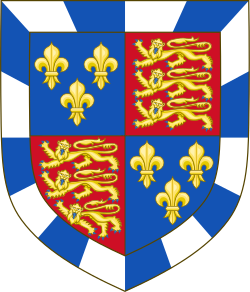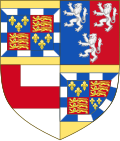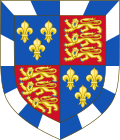Duke of Beaufort
| Dukedom of Beaufort | |
|---|---|
  Quarterly, 1st and 4th, azure three fleurs-de-lys or (for France); 2nd and 3rd, gules three lions passant guardant in pale or (for England), all within a bordure compony argent and azure | |
| Creation date | 2 December 1682 |
| Created by | Charles II |
| Peerage | Peerage of England |
| First holder | Henry Somerset, 3rd Marquess of Worcester |
| Present holder | Henry Somerset, 12th Duke of Beaufort |
| Heir apparent | Henry Robert FitzRoy Somerset, Marquess of Worcester |
| Remainder to | 1st Duke's heirs male of the body lawfully begotten |
| Subsidiary titles | Marquess of Worcester Earl of Worcester Earl of Glamorgan (courtesy) Viscount Grosmont (courtesy) |
| Seat(s) | Badminton House (since the 17th century) |
| Former seat(s) | Raglan Castle (until 1646) |
| Motto | Mutare vel timere sperno (Latin for 'I scorn to change or to fear')[1] |
Duke of Beaufort (/ˈboʊfərt/ BOH-fərt)[2] is a title in the Peerage of England. It was created by Charles II in 1682 for Henry Somerset, 3rd Marquess of Worcester, a descendant of Charles Somerset, 1st Earl of Worcester, legitimised son of Henry Beaufort, 3rd Duke of Somerset, a Lancastrian leader in the Wars of the Roses. The name Beaufort refers to a castle in Champagne, France (now Montmorency-Beaufort). It is the only current dukedom to take its name from a place outside the British Isles.[citation needed]
The Dukes of Beaufort descend in the male line from the House of Plantagenet through John of Gaunt, son of Edward III. This statement was challenged after the analysis of the Y chromosomal DNA of the remains of Richard III. Most living male heirs of the 5th Duke of Beaufort were found to carry a relatively common Y chromosome type, which is different from the rare lineage found in Richard III's remains. The instance of false paternity could have occurred anywhere in the numerous generations separating Richard III from the 5th Duke of Beaufort.[3] The break also could have occurred with Richard III's grandfather Richard of Conisburgh, whose paternity has been called into question although he was acknowledged by his father.
The Beaufort Castle was in possession of John of Gaunt, and the surname Beaufort was given to Gaunt's four legitimised children by his mistress and third wife, Katherine Swynford. This was the foundation of the House of Beaufort, Dukes of Somerset. A descendant of the Beauforts through his mother was Henry VII of England. Charles Somerset, 1st Earl of Worcester, KG (c. 1460 – 15 March 1526), was the bastard son of Henry Beaufort, 3rd Duke of Somerset by his mistress Joan Hill.[4]
The Duke of Beaufort holds two subsidiary titles – Marquess of Worcester (created 1642) and Earl of Worcester (created 1514). The title of Marquess of Worcester is used as a courtesy title by the duke's eldest son and heir. The title of Earl of Glamorgan is used by the eldest son of the heir apparent to the dukedom. The Earl of Glamorgan's eldest son is known as Viscount Grosmont. The Earldom of Glamorgan and Viscountcy of Grosmont derive from an irregular creation in 1644 by Charles I in favour of Edward Somerset, who later succeeded his father as 2nd Marquess of Worcester.
Although the Earldom of Glamorgan and Viscountcy of Grosmont were not recognised as substantive titles at the restoration of Charles II, because of irregularities in the patent of creation, they have nevertheless continued to be used as convenient courtesy titles in order to distinguish the bearer from the Marquess of Worcester as heir apparent, the Earldom of Worcester not being distinctive enough for this purpose. All subsidiary titles are in the Peerage of England.
Field Marshal The Lord Raglan, born Lord FitzRoy Somerset (1788–1855), was the youngest son of the fifth duke.
The family seat was once Raglan Castle in Monmouthshire, but as of 2017[update] was Badminton House near Chipping Sodbury in Gloucestershire. The principal burial place of the Dukes and Duchesses of Beaufort is St Michael and All Angels' Church, Badminton.
Following the creation of the dukedom, each successive duke has served as Master of the Duke of Beaufort's Hunt, a foxhound pack kenneled on the Badminton Estate.
Descent from John of Gaunt
[edit]- John of Gaunt, son of King Edward III and father of King Henry IV of England
- John Beaufort, 1st Earl of Somerset, natural and legitimized son of John of Gaunt by Katherine Swynford
- Edmund Beaufort, 4th Earl and 2nd Duke of Somerset, fourth and youngest son of the 1st Earl
- Henry Beaufort, 3rd Duke of Somerset, son of the 4th Earl and 2nd Duke of Somerset; his natural son was created Earl of Worcester in 1514.
Earls of Worcester (1514)
[edit]- Charles Somerset, 1st Earl of Worcester (c. 1450–1526), legitimised son of Henry Beaufort, 3rd Duke of Somerset and Joan Hill
- Other titles (2nd onwards): Baron Herbert (1461)
- Henry Somerset, 2nd Earl of Worcester (c. 1495–1548), only legitimate son of the 1st Earl
- William Somerset, 3rd Earl of Worcester (died 1589), eldest son of the 2nd Earl
- Edward Somerset, 4th Earl of Worcester (1553–1628), only son of the 3rd Earl, was the father of the 5th Earl and Lady Blanche Arundell
- Henry Somerset, 5th Earl of Worcester (1577–1646) was created Marquess of Worcester in 1643
Marquesses of Worcester (1642)
[edit]- Other titles: Earl of Worcester (1514) and Baron Herbert (1461)
- Henry Somerset, 1st Marquess of Worcester (1577–1646), eldest son of the 4th Earl, was a noted Cavalier
- Edward Somerset, 2nd Marquess of Worcester (1601–1667), eldest son of the 1st Marquess, was an inventor. He has a claim to the invention of the steam engine.
- Henry Somerset, 3rd Marquess of Worcester (1629–1700) was created Duke of Beaufort in 1682, after the Restoration
- Henry Somerset, Lord Herbert (b. bef. 1660), eldest son of the 3rd Marquess, died in infancy
Dukes of Beaufort (1682)
[edit]- Other titles: Marquesses of Worcester (1642) and Earl of Worcester (1514)
- Other titles (1st–10th Dukes): Baron Herbert (1461)
- Henry Somerset, 1st Duke of Beaufort (1629–1700), eldest son of the 2nd Marquess
- Henry Somerset, Lord Herbert (b. before 1660), eldest son of the 1st Duke, died in infancy
- Charles Somerset, Marquess of Worcester (1660–1698), second son of the 1st Duke, predeceased his father
- Henry Somerset, 2nd Duke of Beaufort (1684–1714), only son of the Marquess of Worcester
- Henry Scudamore, 3rd Duke of Beaufort (1707–1745), eldest son of the 2nd Duke, died without issue
- Charles Noel Somerset, 4th Duke of Beaufort (1709–1756), second and youngest son of the 2nd Duke
- Other titles (5th–10th Dukes): Baron Botetourt (1305; abeyance ended 1803)
- Henry Somerset, 5th Duke of Beaufort (1744–1803), only son of the 4th Duke
- Henry Charles Somerset, 6th Duke of Beaufort (1766–1835), eldest son of the 5th Duke
- Henry Somerset, 7th Duke of Beaufort (1792–1853), eldest son of the 6th Duke
- Henry Charles FitzRoy Somerset, 8th Duke of Beaufort (1824–1899), only son of the 7th Duke
- Henry Adelbert Wellington FitzRoy Somerset, 9th Duke of Beaufort (1847–1924), eldest son of the 8th Duke
- Henry Hugh Arthur FitzRoy Somerset, 10th Duke of Beaufort (1900–1984), only son of the 9th Duke, died without issue, at which point his two Baronies fell into abeyance.
- David Robert Somerset, 11th Duke of Beaufort (1928–2017), great-grandson of Rt. Hon. Lord Henry Richard Charles Somerset, second son of the 8th Duke
- Henry John FitzRoy Somerset, 12th Duke of Beaufort (b. 22 May 1952), eldest son of the 11th Duke.[4]
The heir apparent is the present holder's son, Henry Robert FitzRoy Somerset, Marquess of Worcester (b. 20 January 1989).[4]
Line of succession (simplified) |
|---|
|
- Bookplate with the arms of the 2nd Duke of Beaufort
- Bookplate with the arms of Elizabeth Somerset, wife of the 5th Duke of Beaufort
- Bookplate with the arms of the 9th Duke of Beaufort
Coat of arms
[edit]The heraldic blazon for the coat of arms of the dukedom is: Quarterly, 1st and 4th, azure three fleurs-de-lys or (for France); 2nd and 3rd, gules three lions passant guardant in pale or (for England), all within a bordure compony argent and azure.
This can be translated as: a shield divided into quarters, the top left and bottom right quarters are blue with three golden fleurs-de-lys (for France), and the top right and bottom left quarters are red with three golden lions passant with their faces toward the viewer, one above the other (for England); the foregoing quarters are within a border around the shield with segments alternating white and blue.
In heraldry, a bordure compony is traditionally used to designate illegitimacy. Since the original Beaufort siblings' father was of the English royal family, the English royal arms are used. At that time, the king of England also claimed the French crown, hence the inclusion of the French royal arms.
 |
|
Family tree
[edit]| Family tree of the Dukes of: Beaufort, Dorset, Lancaster, and Somerset, Marquesses of: Dorset, Hertford, Somerset and Worcester, and Earls of: Dorset, Hertford, Lancaster, Leicester, Middlesex, Somerset, Worcester, and Yarmouth (3rd creation) | |||||||||||||||||||||||||||||||||||||||||||||||||||||||||||||||||||||||||||||||||||||||||||||||||||||||||||||||||||||||||||||||||||||||||||||||||||||||||||||||||||||||||||||||||||||||||||||||||||||||||||||||||||||||||||||||||||||||||||||||||||||||||||||||||||||||||||||||||||||||||||||||||||||||||||||||||||||||||||||||||||||||||||||||||||||||||||||||||||||||||||||||||||||||||||||||||||||||||||||||||||||||||||||||||||||||||||||||||||||||||||||||||||||||||||||||||||||||||||||||||||||||||||||||||||||||||||||||||||||||||||||||||||||||||||||||||||||||||||||||||||||||||||||||||||||||||||||||||||||||||||||||||||||||||||||||||||||||||||||||||||||||||||||||||||||||||||||||||||||||||||||||||||||||||||||||||||||||||||||||||||||||||||||||||||||||||||||||||||||||||||||||||||||||||||||||||||||||||||||||||||||||||||||||||||||||||||||||||||||||||||||||||||||||||||||||||||||||||||||||||||||||||||||||||||||||||||||||||||||||||||||||||||||||||||||||||||||||||||||||||||||||||||||||||||||||||||||||||||||||
|---|---|---|---|---|---|---|---|---|---|---|---|---|---|---|---|---|---|---|---|---|---|---|---|---|---|---|---|---|---|---|---|---|---|---|---|---|---|---|---|---|---|---|---|---|---|---|---|---|---|---|---|---|---|---|---|---|---|---|---|---|---|---|---|---|---|---|---|---|---|---|---|---|---|---|---|---|---|---|---|---|---|---|---|---|---|---|---|---|---|---|---|---|---|---|---|---|---|---|---|---|---|---|---|---|---|---|---|---|---|---|---|---|---|---|---|---|---|---|---|---|---|---|---|---|---|---|---|---|---|---|---|---|---|---|---|---|---|---|---|---|---|---|---|---|---|---|---|---|---|---|---|---|---|---|---|---|---|---|---|---|---|---|---|---|---|---|---|---|---|---|---|---|---|---|---|---|---|---|---|---|---|---|---|---|---|---|---|---|---|---|---|---|---|---|---|---|---|---|---|---|---|---|---|---|---|---|---|---|---|---|---|---|---|---|---|---|---|---|---|---|---|---|---|---|---|---|---|---|---|---|---|---|---|---|---|---|---|---|---|---|---|---|---|---|---|---|---|---|---|---|---|---|---|---|---|---|---|---|---|---|---|---|---|---|---|---|---|---|---|---|---|---|---|---|---|---|---|---|---|---|---|---|---|---|---|---|---|---|---|---|---|---|---|---|---|---|---|---|---|---|---|---|---|---|---|---|---|---|---|---|---|---|---|---|---|---|---|---|---|---|---|---|---|---|---|---|---|---|---|---|---|---|---|---|---|---|---|---|---|---|---|---|---|---|---|---|---|---|---|---|---|---|---|---|---|---|---|---|---|---|---|---|---|---|---|---|---|---|---|---|---|---|---|---|---|---|---|---|---|---|---|---|---|---|---|---|---|---|---|---|---|---|---|---|---|---|---|---|---|---|---|---|---|---|---|---|---|---|---|---|---|---|---|---|---|---|---|---|---|---|---|---|---|---|---|---|---|---|---|---|---|---|---|---|---|---|---|---|---|---|---|---|---|---|---|---|---|---|---|---|---|---|---|---|---|---|---|---|---|---|---|---|---|---|---|---|---|---|---|---|---|---|---|---|---|---|---|---|---|---|---|---|---|---|---|---|---|---|---|---|---|---|---|---|---|---|---|---|---|---|---|---|---|---|---|---|---|---|---|---|---|---|---|---|---|---|---|---|---|---|---|---|---|---|---|---|---|---|---|---|---|---|---|---|---|---|---|---|---|---|---|---|---|---|---|---|---|---|---|---|---|---|---|---|---|---|---|---|---|---|---|---|---|---|---|---|---|---|---|---|---|---|---|---|---|---|---|---|---|---|---|---|---|---|---|---|---|---|---|---|---|---|---|---|---|---|---|---|---|---|---|---|---|---|---|---|---|---|---|---|---|---|---|---|---|---|---|---|---|---|---|---|---|---|---|---|---|---|---|---|---|---|---|---|---|---|---|---|---|---|---|---|---|---|---|---|---|---|---|---|---|---|---|---|---|---|---|---|---|---|---|---|---|---|---|---|---|---|---|---|---|---|---|---|---|---|---|---|---|---|---|---|---|---|---|---|---|---|---|---|---|---|---|---|---|---|---|---|---|---|---|---|---|---|---|---|---|---|---|---|---|---|---|---|---|---|---|---|---|---|---|---|---|---|---|---|---|---|---|---|---|---|---|---|---|---|---|---|---|---|---|---|---|---|---|---|---|---|---|---|---|---|---|---|---|---|---|---|---|---|---|---|---|---|---|---|---|---|---|---|---|---|---|---|---|---|---|---|---|---|---|---|---|---|---|---|---|---|---|---|---|---|---|---|---|---|---|---|---|---|---|---|---|---|---|---|---|---|---|---|---|---|---|---|---|---|---|---|---|---|---|---|---|---|---|---|---|---|---|---|---|---|---|---|---|---|---|---|---|---|---|---|---|---|---|---|---|---|---|---|---|---|---|---|---|---|---|---|---|---|---|---|---|---|---|---|---|---|---|---|---|---|---|---|---|---|---|---|---|---|---|---|---|---|---|---|---|---|---|---|---|---|---|---|---|---|---|---|---|---|---|---|---|---|---|---|---|---|---|---|---|---|---|---|---|---|---|---|---|---|---|---|---|---|---|---|---|---|---|---|---|---|---|---|---|---|---|---|---|---|---|---|---|---|---|---|---|---|---|---|---|---|---|---|---|---|---|---|---|---|---|---|---|---|---|---|---|---|---|---|---|---|---|---|---|---|---|---|---|---|---|---|---|---|---|---|---|---|---|---|---|---|---|---|---|---|---|---|---|
| |||||||||||||||||||||||||||||||||||||||||||||||||||||||||||||||||||||||||||||||||||||||||||||||||||||||||||||||||||||||||||||||||||||||||||||||||||||||||||||||||||||||||||||||||||||||||||||||||||||||||||||||||||||||||||||||||||||||||||||||||||||||||||||||||||||||||||||||||||||||||||||||||||||||||||||||||||||||||||||||||||||||||||||||||||||||||||||||||||||||||||||||||||||||||||||||||||||||||||||||||||||||||||||||||||||||||||||||||||||||||||||||||||||||||||||||||||||||||||||||||||||||||||||||||||||||||||||||||||||||||||||||||||||||||||||||||||||||||||||||||||||||||||||||||||||||||||||||||||||||||||||||||||||||||||||||||||||||||||||||||||||||||||||||||||||||||||||||||||||||||||||||||||||||||||||||||||||||||||||||||||||||||||||||||||||||||||||||||||||||||||||||||||||||||||||||||||||||||||||||||||||||||||||||||||||||||||||||||||||||||||||||||||||||||||||||||||||||||||||||||||||||||||||||||||||||||||||||||||||||||||||||||||||||||||||||||||||||||||||||||||||||||||||||||||||||||||||||||||||||
Ancestral armorial
[edit]
| Arms | Name | Life | Blazon | Notes |
|---|---|---|---|---|
 | Charles Somerset, 1st Earl of Worcester, K.G. | 1460–1526 | Quarterly, 1st and 4th, France ancien, 2nd and 3rd England, within a bordure componée Argent and Azure[7] (Beaufort)with argent baton sinister, with escutcheon of pretence of per pale azure and gules, three lions rampant argent, 2 and 1 Herbert. | An illegitimate son of Henry Beaufort, 3rd Duke of Somerset[8] by his mistress Joan Hill.[9] He was invested as a Knight of the Garter in about 1496. On 1 February 1514 he was created Earl of Worcester and was at some time appointed Lord Chamberlain of the Household to King Henry VIII. As Lord Chamberlain, Somerset was largely responsible for the preparations for the Field of Cloth of Gold in 1520. He was a favourite of Henry VII and Henry VIII |
| Arms | Name | Life | Blazon | Notes |
|---|---|---|---|---|
 | William Somerset, 3rd Earl of Worcester, K.G. | 1526/7–1589 | Quarterly, 1st and 4th, or a fess on which is France moderne, 2nd and 3rd England, within a bordure componée Argent and Azure[10] (Beaufort), 2nd, per pale azure and gules, three lions rampant argent, 2 and 1 Herbert, argent a fess gules, with a canton gueules.[11] | Eldest son of Henry Somerset, 2nd Earl of Worcester and his second wife Elizabeth Browne.[12] |
| Arms | Name | Life | Blazon | Notes |
|---|---|---|---|---|
 | Edward Somerset, 4th Earl of Worcester, K.G. | 1550–1628 | Grand quarters, 1st and 4th, quarterly, 1st and 4th, France moderne, 2nd and 3rd England, within a bordure componée Argent and Azure[10] (Beaufort), 2nd, per pale azure and gules, three lions rampant argent, 2 and 1 Herbert, argent a fess gules, with a canton gueules. | Eldest son of William Somerset, 3rd Earl of Worcester. He was an important advisor to King James I (James VI of Scots), serving as Lord Privy Seal.[12] |
| Arms | Name | Life | Blazon | Notes |
|---|---|---|---|---|
 | Henry Somerset, 1st Duke of Beaufort, K.G., PC | 1629–1700 | Quarterly, 1st and 4th, France moderne, 2nd and 3rd England, within a bordure componée Argent and Azure[10] (Beaufort). | Eldest son of Edward Somerset, 2nd Marquess of Worcester. He was a Welsh politician who sat in the House of Commons at various times between 1654 and 1667, when he succeeded his father as 3rd Marquess of Worcester. He was styled Lord Herbert from 1644 until 3 April 1667. The Dukedom of Beaufort was bestowed upon him by King Charles II in 1682. He is the ancestor of the current Somersets, and so the Dukes of Beaufort and the Barons Raglan. The current head of the house is Henry Somerset, 12th Duke of Beaufort. |
See also
[edit]References
[edit]- ^ Woods, Judith (10 December 2013). "Lord Edward Somerset: a fine pedigree counts for nothing". The Daily Telegraph. Retrieved 3 December 2016.
- ^ Wells, John C. (2008). Longman Pronunciation Dictionary (3rd ed.). Longman. ISBN 978-1-4058-8118-0.
- ^ "Richard III's DNA throws up infidelity surprise". BBC News. 2 December 2014. Retrieved 18 August 2017.
- ^ a b c Mosley, Charles, ed. (2003). Burke's Peerage, Baronetage & Knighthood (107 ed.). Burke's Peerage & Gentry. p. 301. ISBN 0-9711966-2-1.
- ^ Mosley, Charles, ed. (1999). "Beaufort". Burke's Genealogical and Heraldic History of the Peerage, Baronetage and Knightage. Vol. 1 (106th ed.). Crans, Switzerland: Burke's Peerage (Genealogical Books) Ltd. pp. 220–226. ISBN 2-940085-02-1.
- ^ Morris, Susan; Bosberry-Scott, Wendy; Belfield, Gervase, eds. (2019). "Beaufort". Debrett's Peerage and Baronetage. Vol. 1 (150th ed.). London: Debrett's Ltd. pp. 500–507. ISBN 978-1-999767-0-5-1.
- ^ Pinches & Pinches 1974, p. 81.
- ^ Burke 1914, p. 207.
- ^ Gurney 1890, p. 55.
- ^ a b c Pinches & Pinches 1974, p. 82.
- ^ Quartering based on the arms in the 16th century portrait of Worcester (Portrait of William Somerset, 3rd Earl of Worcester 2018)
- ^ a b Robinson 2004.
Bibliography
[edit]- "Portrait of William Somerset, 3rd Earl of Worcester". Wikimedia Commons. 13 July 2018.
- Robinson, W.R.B. (2004), "Somerset, William, third earl of Worcester", Oxford Dictionary of National Biography (online ed.), Oxford University Press, doi:10.1093/ref:odnb/26015 (Subscription or UK public library membership required.)
- Gurney, E. Henry (1890). Reference handbook for readers, students, and teachers of English history. Boston: Ginn & Company. p. 55.
- Pinches, John Harvey; Pinches, Rosemary (1974). The Royal Heraldry of England. Heraldry Today. Slough, Buckinghamshire: Hollen Street Press. ISBN 0-900455-25-X.[page needed]
- Burke, John (1914). Burke's genealogical and heraldic history of peerage, baronetage and knightage. New York: G.P.Putnam's Sons. p. 207.
- Hesilrige, Arthur G. M. (1921). Debrett's Peerage and Titles of courtesy. London: London: Dean & son, limited. p. 100.
External links
[edit] Media related to Dukes of Beaufort at Wikimedia Commons
Media related to Dukes of Beaufort at Wikimedia Commons


 French
French Deutsch
Deutsch


